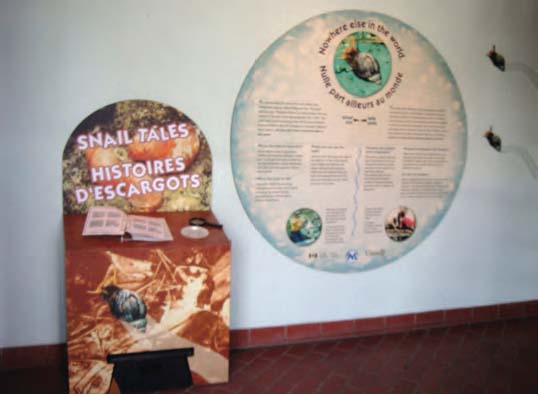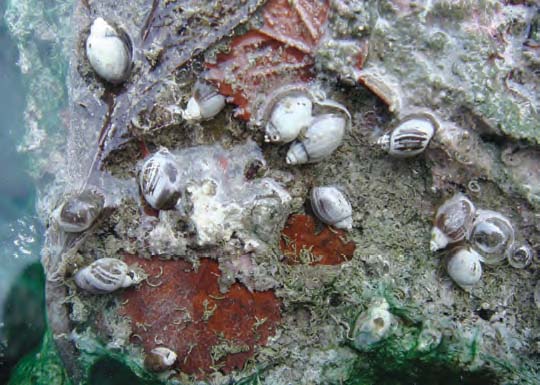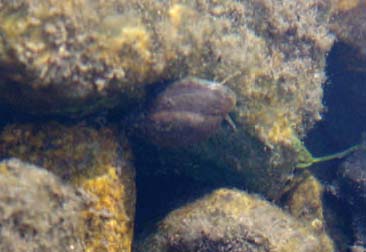Issue
17
Page
28
|
On a winter trip to Banff, Alberta, in the Canadian Rockies earlier this year, I was not expecting to encounter any snails: most would be hidden, deep in the soil or at the bottom of lakes, trying to escape the deep snow and a temperature which one day was as low as -20°C. However I was surprised to see, on a visit to the Information Centre of the Cave and Basin National Historic Site, about 1 mile outside Banff above the Bow River, a display (Figure 1) about an unusual snail that is found in the local sulphurous thermal springs: points of groundwater discharge that form the mineral pools which are characteristic of the area.
Physella johnsoni (Clench, 1926) is a small (c.5-8mm shell length) member of the Physidae family of freshwater snails. It is endemic to only five thermal springs on Sulphur Mountain in the Banff National Park. DNA evidence suggests that the species evolved recently in the springs; since the retreat of the glaciers around twelve thousand years ago. Thermal springs are often altered for human use, resulting in a loss of native species and ecological integrity and this has been the case for several of the Banff springs which no longer harbour the snail. Thermal springs can be considered harsh environments with high temperatures (in this case 30-35°C), high concentrations of dissolved minerals and low dissolved oxygen levels. Seasonal fluctuations in flow rates also occur, leading to changes in sulphur and dissolved oxygen levels which effect the growth of the floating bacterial/algal communities on which the snails live.
Physella johnsoni made history in 1997 as the first living mollusc listed by the Committee on the Status of Endangered Wildlife in Canada and National Parks Canada is actively working to protect the snail, through research and conservation. I was very pleased to be able to observe many individuals of the snail crawling on floating mats of algae (Figure 2), both in the former public pool (Figure 3) at the visitor centre and also in the pools of emerging springs in the woods of the mountain above (Figure 4). Gastropods can have important effects on algal production and P. johnsoni are important grazers in the thermal spring ecosystems as well as contributing organic nutrients. Thus the snail may be a keystone species, the absence of which could seriously shift the ecosystem of the hot springs.
On the outskirts of Banff to the North are three lakes known as the Vermillion Lakes. Walking in the area I saw that the ice and compacted snow was thick enough on the first two lakes to walk across them, but I noticed that an area of the third lake remained unfrozen. The reason for this became clear when I discovered another spring emerging from rocks at the bottom of a slope that was constructed in the 1950’s to take the Trans Canada Highway which runs along the Northern edge of the lakes. It turned out that this spring is the remains of the Vermillion Cool Spring whose natural course was altered when the highway was built. The water of this spring has a 1 temperature of 18-19°C and may have once held a population of P. johnsoni, although this is debatable since although classified as a thermal spring, the level of dissolved mineral salts here is lower than in the other springs. I noticed that there were mats of algae present and there were Physella snails active on the rocks of the spring itself and also in small unfrozen pools at the edge of the lake (Figure 5). These however turned out to be individuals of the larger, widespread and common Physella gyrina, although it was interesting to see that that raised water temperature caused these animals to be active when nearby lakes were under ice.
More details of the conservation efforts to help preserve this interesting snail can be found on the Parks Canada’s web site at: www.parkscanada.gc.ca/speciesatrisk/ and from the publication sited below (which is also available online).
Reference
Lepitzki, D.A.W. 2002. Status of the Banff Springs Snail (Physella johnsoni) in Alberta. Alberta Sustainable Resource Development, Fish and Wildlife Division, and Alberta Conservation Association, Wildlife Status Report No. 40, Edmonton, AB.
|
Figure 1
Figure 2
Figure 3
Figure 4
Figure 5 |





